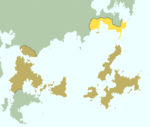Shaaniaah
 |
 |

| |
| Country | |
|---|---|
| Capital | Kin Haala |
| Area | 220,859 km2 |
| Population | 11,858,501 |
| Density | 53.7/km2 |
| Demonym | Shaanian |
| Time zone | UTC-10 |
Shaaniaah is a founding member state of Sokoku, located on the Altaian mainland in the country's far east. It is commonly referred to in many languages simply as Shania but Sokokan authorities have stimulated the use of the proper name for the last decades. The name Shaaniaah is mainly used in the local Izto language. In Bahaso Sokoku the member state is called Tanya Tanah, which is also used as the official name within Sokoku. Other names like Shensutochi (しえんすとち) in Kakuri or Bågeland in Wortsproke don't have an official status.
As a territorial unit, it is a continuation of the Hallish colony of Bowersland, which with the help of makeshift forces from Fisks and Shuuen was liberated in 76XX. It was one of the founding states of the federative republic of Sokoku. Inclusion of the rather sparsely populated territory on the mainland with its totally different cultural and ethnic background was one of the deciding factors in creating a multi-ethnic state in this region of the Julian Sea.
Shaaniaah used to be the least populated of the member states after Mirei but transmigration from the islands and immigration from other Altaian nations has led to a large increase in population. Especially the steel and port towns of To Bei Nihaa (Tobeyi Niha) and Chisha (Cisya) have grown from small fishing towns to urban areas with over a million inhabitants within a few decades. Main reason is the iron mining and accompanying iron works and shipping industry that has been started here. This partially as a way to avoid cities like Berewan, Suryanagara and Tangkota in other member states growing too large.
The countryside is rather undeveloped. Parts of the tropical jungle have been turned into mixed tree plantations for timber and fruit production, while coastlands have some fertile agricultural regions where typical Shanian produce like potatoes, corn and tomatoes are grown. Through careful urban and infrastructure planning, these regions are connected to the port towns with their large demand for food items, as well as the possibilities for further transport towards the islands. Outside the urbanised regions the population density averages about 30 people per square kilometer, with about half the territory being as good as without any population as all.